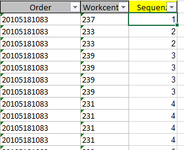Hi all,
I am using table with multiple columns, but for this operation query needs just two columns + one custom column named Sequence with formula.
For example, I have columns [Order] and [Workcenter].
Formula should look like this:
=IF(row2.Order<>row1.Order,1,IF(row2.Order&row2.Workcenter<>row1.Order&row1.Workcenter,Sequence+1,Sequence))
=IF(H4<>H3,1,IF(H4&L4<>H3&L3,T3+1,T3)) -> This is presentation how it would look like in Excel.

But I want to get rid of excel file and to work with database. Right now I work with all data in Access and just because of this step I have to manually copy data into excel to calculate via formula
Does anyone have idea how it would work?
I am using table with multiple columns, but for this operation query needs just two columns + one custom column named Sequence with formula.
For example, I have columns [Order] and [Workcenter].
Formula should look like this:
=IF(row2.Order<>row1.Order,1,IF(row2.Order&row2.Workcenter<>row1.Order&row1.Workcenter,Sequence+1,Sequence))
=IF(H4<>H3,1,IF(H4&L4<>H3&L3,T3+1,T3)) -> This is presentation how it would look like in Excel.
But I want to get rid of excel file and to work with database. Right now I work with all data in Access and just because of this step I have to manually copy data into excel to calculate via formula
Does anyone have idea how it would work?






